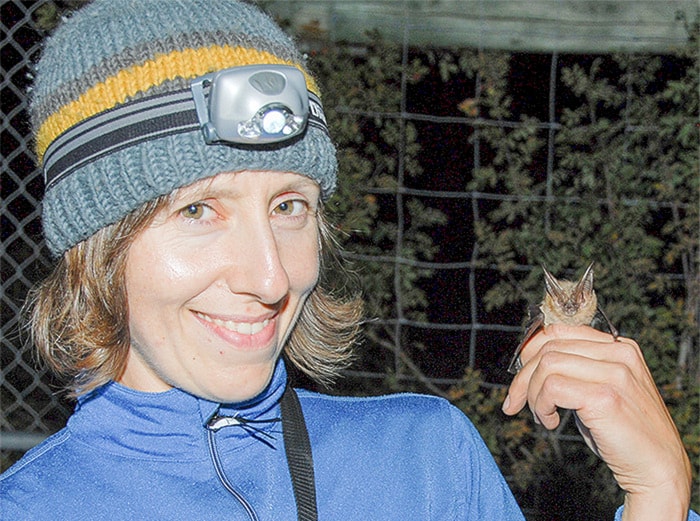Summer twilight is a time for many special things: long walks on the beach with a loved one, evening concerts in the park … and bats.
“There is always a lot of interest in bats in the summer,” said Margaret Holm, a co-ordinator with the Okanagan Bat Project, which wants to reduce the mystery and fear associated with these nocturnal insect predators and support bat conservation by providing information about bats and getting the public’s assistance with locating and monitoring bat populations.
When it comes to bats, B.C. is unique for the number of bat species, and within B.C., the Okanagan has more types of bats than anywhere else.
Holm said there are 15 species of bats that can be found in the Okanagan, including some special varieties, like the pallid bat, a blonde-furred species that flies low over the antelope brush grasslands in the southern part of the valley, hunting for ground insects.
“We have a spotted bat that is a beautiful black with white spots on it, and it is unique in that you can actually hear its echolocation calls. It is low enough you can hear those clicks; most bats it is beyond human hearing,” said Holm.
“And we have bats with outrageously huge ears, the Townsend’s Big-eared bat.”
To help people learn about bats, the project has set up a call line at 1-855-9BC-BATS where people can call with their questions or to report colonies in their area.
“It seems like half the people I talk to want some help with bats in their building, the other half want to attract more bats. We can help with both those things,” said Holm. “We can answer health and safety concerns. And we are very interested in finding out about maternal colonies.
“These are the groups from 20 to 200, or even larger groups of female bats that give birth to pups.”
Each bat species has its own preferred habitat, Holm explained, including the common brown bats and yuma bats that often make their way into homes.
“There is not a lot of habitat choices for them. So they do choose houses sometimes, or people sometimes want them so they are erecting structures that become bat habitat,” said Holm.
“We want to find out where those maternal colonies are and get peoples’ help to count them, but also maybe to help those people understand their importance.”
One such colony, she said, lives in an abandoned elementary school in Peachland, with about 1,000 or more bats.
In the Peachland area there is an old elementary school which is home to more than 1,000 bats.
Some in the town have made it into something of a tourist attraction, selling t-shirts and building a website for the bat colony at peachlandbats.ca, which includes a live cam feed.
Then there are the solo bats.
“These are usually single bachelor bats, the males that aren’t in the colonies, they are just finding a spot to roost during the day,” said Holm. “Underneath patio umbrellas is a familiar place where some people might roll it out and discover there is a bat in there.”
Holm also said that while the problem of bats carrying diseases, like rabies, exists, it is not as prevalent as people fear.
“With all wildlife there is a small percentage of the population that does carry some disease. For instance, people should never pick up a bat with their bare hands. But the incidence of rabies is thought to be quite low in the wild bat population,” said Holm, adding that is corroborated by a low incidence of rabies in the dead or injured bats brought in for testing.
“Bats really contribute. They are a good insect hunters, they really contribute to keeping insects under control for agriculture and for us too. They do provide a value to us and we want to make sure we keep bats safe,” said Holm.
“We’d love to hear from people who notice bats entering buildings on their property.
“And for those who want to attract bats there are a variety of bat house and bat roost options. We can give homeowners suggestions about supporting their bat habitat, or if needed, figuring out the best method and time of year to exclude the bats without endangering the adults or young.”
The Okanagan Community Bat Program is funded by the Habitat Conservation Trust Foundation and can be reached by calling 1-855-9BC-BATS or online at www.bcbats.ca.
